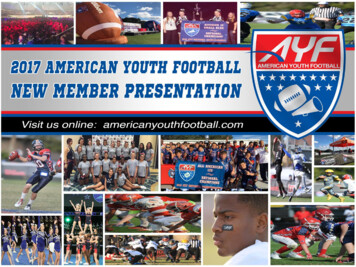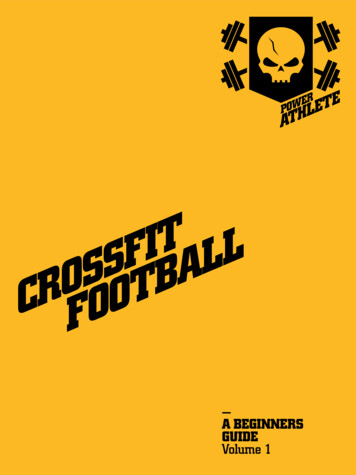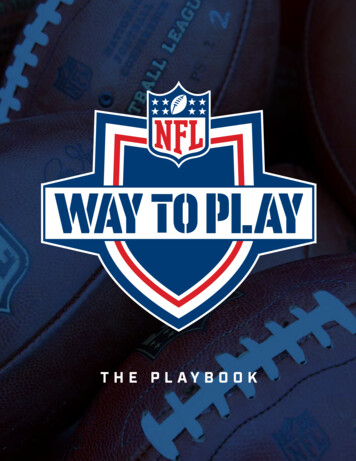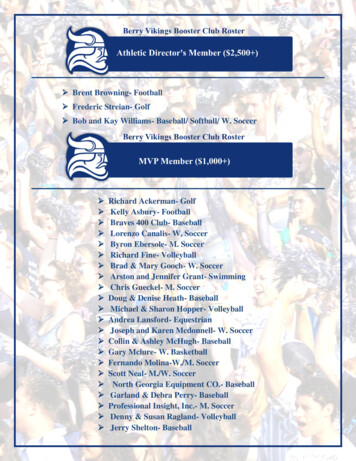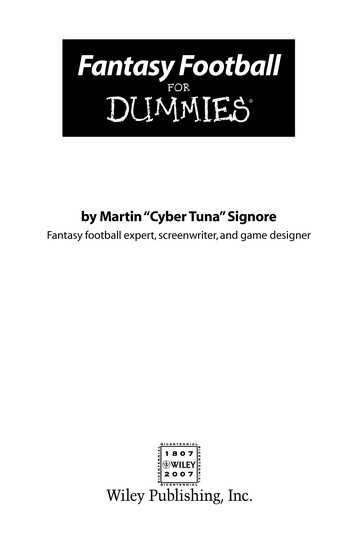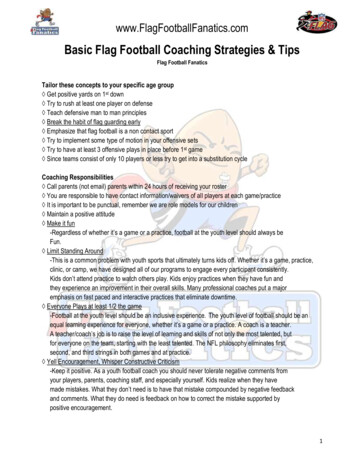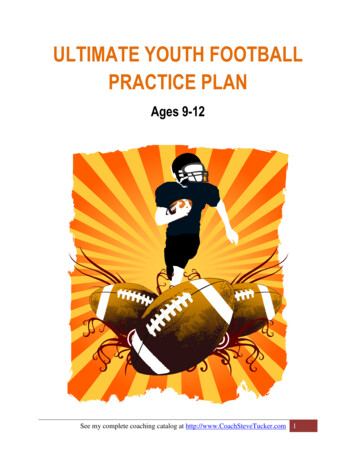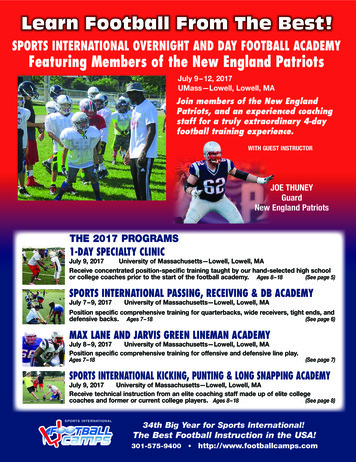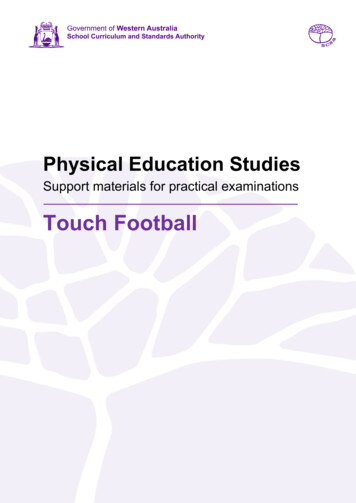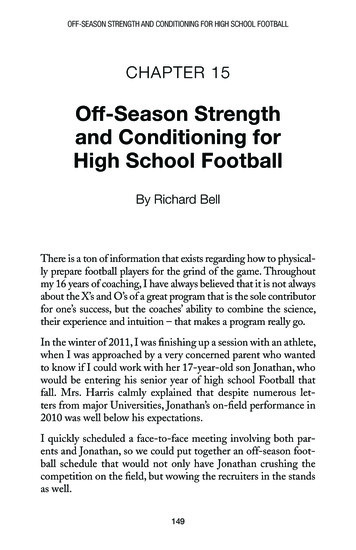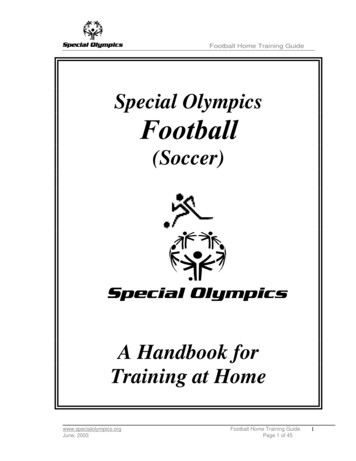
Transcription
Football Home Training GuideSpecial Olympics(Soccer)A Handbook forTraining at Homewww.specialolympics.orgJune, 2003Football Home Training GuidePage 1 of 451
Football Home Training GuideThe most crucial part of the Home Training Program is the Family. This includes anathlete’s extended family and caretakers, individuals who are significant to that athlete.Parent or sibling involvement is a key factor that motivates and enables athletes to playsports outside of their formal practices with the coach.Athletes and family members frequently say that they enjoy Special Olympics because ithelps teach skills that enable athletes and their families to enjoy sports together incommunity sports programs as well as Special Olympics. The Home Training Guideprovides tips and activities for athletes and families to follow BETWEEN organizedSpecial Olympics practices.Guidelines for Family Home TrainingA consistent and dependable training routine provides familiarity and stability.Schedule training sessions into the daily routine.Set specific times for workouts during the week.Coaches should communicate with the families periodically throughout the trainingseason. Provide assistance whenever possible. Recognize their time and efforts in theathlete’s development and the success of the Program.www.specialolympics.orgJune, 2003Football Home Training GuidePage 2 of 452
Football Home Training GuideTable of ContentsMy Football (Soccer) Schedule / Coach / TeammatesThe Key to Long-term Athlete ImprovementMy Goals for the SeasonCoach’s Goals for the SeasonSpecial Olympics Athlete’s Code of ConductFacts About Special OlympicsAthlete Leadership ProgramsIntroduction to Football (Soccer)Equipment and ClothingSun SafetyThe Fitness/Nutrition Wheel!Fitness/Nutrition BuildersAthlete Action: A Special Olympics Athlete’s HomeTraining ChartTraining LogSample Warm-up/Stretching ActivitiesSample Football (Soccer) Skill Development ActivitiesSample Strength and Conditioning ActivitiesAppendix A: Weekly Home Training PlanAppendix B: Sample Off-Season Training Planwww.specialolympics.orgJune, 2003Football Home Training GuidePage 3 of 453
Football Home Training GuideMy Football (Soccer)ScheduleTeam Name:PracticeDate/TimeCoaches’ Name(s):Phone Numbers:Email Address:Namewww.specialolympics.orgJune, 2003LocationCompetitionsDate/TimeLocationMy Teammates!Phone NumberEmail/otherFootball Home Training GuidePage 4 of 454
Football Home Training GuideThe Key to Long-term Athlete ImprovementBy Mike SmithSpecial Olympics, Inc.Managing Director, Special Olympics Europe/EurasiaFor any athlete or player preparing for the Olympics or Special Olympics, the hoursof training and free-play spent in addition to regular practice time are perhaps the mostimportant part of becoming an accomplished athlete. Morning stretching to developflexibility, daily runs to build up stamina, playing in the backyard or informalcompetition at the local playground are unstructured, personally motivated, activities thathelp athletes succeed in sports. For a Special Olympics athlete, however, such activitiesmay not be a part of everyday life.What happens to an athlete when the local basketball players do not drop by for some1-on-1 in the driveway, when a three mile run, unsupervised, is out of the question orwhen the speed and intensity of the playground game is simply overwhelming? For suchan athlete, learning sports becomes limited to the structured practice time organized bythe coach. And the simple fact is, an athlete who practices a sport for only two or threehours a week will never master the sport.The work that coaches do in their weekly practices is the foundation for SpecialOlympics athletes’ skill development. A coach can establish fundamental skills, introducebasic competition ideas, motivate athletes to participate and improve their performance.However, it is unrealistic to expect a coach, in only a few hours a week, to completelyprepare an athlete for success in competition.Some coaches simply shake their heads at the physical fitness level of their athletesor at their painfully slow rate of development. However, a coach who is truly committedto improving the performance of an athlete can stimulate athletic activities outside oftheir regular practices. How? By utilizing a resource that goes untapped in many SpecialOlympics programs; the energy and commitment of an athlete’s family.Through a simple “Home Training” program for families and training partners,coaches can successfully double or triple the time an athlete spends learning a sport. Inaddition, family participation can have tremendous effect in many other aspects of theoverall Special Olympics program, positively impacting everything from transportation tofund-raising.Guidelines for coaches to establish a successful home training program:1) Talk with parents and siblings to educate them about the goals of SpecialOlympics and the importance of regular training or athletic activity at home andto educate yourself about the lives of your athletes.2) Run a practical session to provide families with some simple activities they canwww.specialolympics.orgJune, 2003Football Home Training GuidePage 5 of 455
Football Home Training Guideorganize at home with their athlete. A home training program can be a great wayfor parents to get back into shape and a way for them to appreciate what SpecialOlympics is trying to achieve.3) Provide an easy to read weekly training plan. For example:a. Warm-tip activities/stretches (15 min.)b. Simple skill development activities (e.g. Passing drill – 5 min.)c. Competition practice (e.g. 1-on-1 play - 10 min.)d.Other activities (e.g. taking your athlete to see a live competition)4) Recruit training partners if an athlete does not have active support from a familyor group home. Contact community organizations such as a high school PartnersClub .5) Monitor an athlete’s activities during the season. Get them excited about trainingon their own. Ask them to report on training they have done at home. Suggestways to improve their training.Coaching excellence requires consideration of the entire athletic life of an athlete.Starting a family home training program is an exciting way of extending a trainingprogram beyond regular practices. It takes time and effort to initiate, but the longterm rewards can be remarkable for everyone involved.www.specialolympics.orgJune, 2003Football Home Training GuidePage 6 of 456
Football Home Training GuideYour Goals for the Season1. What is your best score in each event at the beginning of the season? What is yourgoal for the end of the season.EventDate TestedBeginningGoal ScoreScoreby seasonend2. What is your best event?3. What is your weakest event?4. What skills do you want to learn or improve on this season?www.specialolympics.orgJune, 2003Football Home Training GuidePage 7 of 457
Football Home Training GuideCoach’s Goals for the SeasonBy the end of the season, you should be able to:;;;.During the season, you are expected to:;;;.Special Olympics hopes that as you go through this season youwill set an example for others by becoming a leader among yourteammates and abiding by the Athlete Code of Conduct on the nextpage.www.specialolympics.orgJune, 2003Football Home Training GuidePage 8 of 458
Football Home Training GuideSPECIAL OLYMPICS ATHLETE’S CODE OF CONDUCTSpecial Olympics is committed to the highest ideals of sport and expects all athletes tohonor sports and Special Olympics. All Special Olympics athletes and Unified Partnersagree to the following code:SPORTSMANSHIPI will practice good sportsmanship.I will act in ways that bring respect to me, my coaches, my team, and SpecialOlympics.I will not use bad language.I will not swear or insult other persons.I will not fight with other athletes, coaches, volunteers, or staff.TRAINING AND COMPETITIONI will train regularly.I will learn and follow the rules of my sport.I will listen to my coaches and the officials and ask questions when I do notunderstand.I will always try my best during training, divisioning, and competitions.I will not “hold back” in preliminary competition just to get into an easier finalscompetition division.RESPONSIBILITY FOR MY ACTIONSI will not make inappropriate or unwanted physical, verbal, or sexual advances onothers.I will not smoke in non-smoking areas.I will not drink alcohol or use illegal drugs at Special Olympics events.I will not take drugs for the purpose of improving my performance.I will obey all laws and Special Olympics rules, the International Federation and theNational Federation/Governing Body rules for my sport (s).I understand that if I do not obey this Code of Conduct, I will be subject to a range ofconsequences by my Program or a Games Organizing Committee for a World Games upto and including not being allowed to participate.www.specialolympics.orgJune, 2003Football Home Training GuidePage 9 of 459
Football Home Training GuideThe Mission of Special Olympics:To provide year-round sports training and athleticcompetition in a variety of Olympics-type sports forchildren and adults with mental retardation, givingthem continuing opportunities to develop physical fitness,demonstrate courage, experience joy and participatein the sharing of gifts, skills and friendship with theirfamilies, other Special Olympics athletes and thecommunity.The Special Olympics Oath:LET ME WIN,BUT, IF I CANNOT WIN,LET ME BE BRAVE IN THE ATTEMPTwww.specialolympics.orgJune, 2003Football Home Training GuidePage 10 of 4510
Football Home Training GuideFacts about Special OlympicsIt is a year-round sports training and competitionprogram.There are 26 sports offered globally. Check withyour local director to see which sports areoffered in your area.There are team and individual sports.You must be 8 years old to compete; 5 years oldto train; no upper age limit.Special Olympics is for people with intellectualdisabilities.Special Olympics is free.Special Olympics is an pics.orgJune, 2003Football Home Training GuidePage 11 of 4511
Football Home Training GuideAthlete LeadershipProgramsYOU chooseyour sport!UnifiedSportsAthletescan beOfficialsAthletescan beCoachesAthletescan beVolunteersAthletes canbe on Boardsor CommitteesAthletescan opsAthlete canbe onInputCouncilsIs there a leadership role YOU would like to try out this season?Does your team have a captain? If not, suggest that you elect one!www.specialolympics.orgJune, 2003Football Home Training GuidePage 12 of 4512
Football Home Training GuideINTRODUCTION TO FOOTBALL (Soccer)Football, or Soccer as it is called in some places, is generally considered to be the world'smost popular team sport. Played in just about every country, the sport' s success is due tothe fact that it can be played by boys, girls, men, and women of just about any physicalbuild and ability. Soccer requires little in the way of specialized equipment and isorganized using simple, intuitive rules.Soccer is a particularly appropriate sport for individuals with intellectual disabilities.Football:Involves all of the participants all the time;Is easy to teach, and immediately rewarding to play;Allows relatively rapid initial improvement in skills and basic game understanding;Is a great conditioning activity.Above all, SOCCER IS FUN.Football has grown at a phenomenal rate over the past 15 years. Much of this growth hasbeen through community club associations run by volunteer coaches (mostly parents)who have learned to coach a game in which they have little direct experience. Thewonderful thing about soccer is that you don't need to be an expert to begin playing. Youjust need enthusiasm and a commitment to learn the basics. With some guidance, anyonewith the time and interest can become a successful Special Olympics Footballer and jointhe worldwide Special Olympics Football family.A PREVIEW OF THE FOOTBALL (SOCCER) EVENTS OFFEREDThe Football competition offerings are based upon athletes' ability levels. A summary ofthose competition offerings follows.For athletes with lower ability who do not have the readiness for direct, face-to-faceoffense and defense, competition is offered in individual skills competition.For athletes with average or moderate ability, competition is offered in modified teamcompetition. The game is played in a smaller area and with a few modified rules. Thegame is simpler to understand and provides the transition from individual skills totraditional team play.For athletes with higher ability, competition is offered in traditional 11-a-side team playand Unified soccer.For the actual soccer events offered, see the Official Special Olympics Sports Rules forSoccer.www.specialolympics.orgJune, 2003Football Home Training GuidePage 13 of 4513
Football Home Training GuideEquipment and ClothingAt or before your first practice, your coach should cover these issues. Ifthey forget, you should remind them and then write down the answers. Itwill be helpful for everyone as the season goes along!Equipment Special Olympics will provide for practices andcompetitions:Equipment you need to get or have:What should you wear to practice?www.specialolympics.orgJune, 2003Football Home Training GuidePage 14 of 4514
Football Home Training GuideProtecting Yourself AgainstHarmful SunlightAm I at Risk?Did you know that the number of new cases of skin cancer, and the number of deathscaused by the most serious type of skin cancer are rapidly rising in the United States?This is particularly troubling since the numbers for most cancers have been declining.Sunlight is the main source of ultraviolet radiation (UV) known to damage the skin and tocause skin cancer. The amount of UV exposure depends on the strength of the light, thelength of exposure, and whether the skin is protected. There are no safe UV rays or safesuntans. Sun exposure at any age can cause skin cancer. Your skin and eyes are mostsusceptible to sun damage. You need to be especially careful in the sun if you havenumerous moles, irregular moles, or large moles; freckles or burn before tanning; fairskin, or blond, red, or light brown hair; or spend a lot of time outdoors. Melanoma is themost serious type of skin cancer, and accounts for more than 75 percent of the deaths dueto skin cancer. In addition to skin cancer, sun exposure can cause premature aging of theskin, wrinkles, cataracts, and other eye problems.How Do I Protect Myself From UV Radiation?If you work outdoors, there are five important steps you can take to protect against UVradiation and skin cancer:1. Cover up. Wear clothing to protect as much of your skin as possible. Wear clothingthat does not transmit visible light. To determine if the clothing will protect you, try thistest: Place your hand between the fabric and a light source. If you can see your handthrough the fabric, the garment offers little protection against sun exposure.2. Use a sunscreen with an SPF of 15 or higher. Experts recommend products with aSun Protection Factor, or SPF, of at least 15. The number of the SPF represents the levelof sunburn protection provided by the sunscreen. An SPF 15 blocks out 93 percent of theburning UV rays; an SPF 30 blocks out 97 percent of the burning UV rays. Productslabeled “broad spectrum” block both UVB and UVA radiation. Both UVA and UVBcontribute to skin cancer.Apply sunscreen liberally at least 15 minutes before going outside.Reapply every 2 hours or more frequently if you sweat a lot or are swimming.Warning: Do not depend on sunscreens alone. Combine sunscreen with widebrimmed hats, UV-protective sunglasses, and tightly woven clothing to increaseyour protection against UV radiation.3. Wear a hat. A wide brim hat is ideal because it protects the neck, ears, eyes, forehead,nose, and scalp. A baseball cap provides some protection for the front and top of thehead, but not for the back of the neck or the ears where skin cancers commonly develop.www.specialolympics.orgJune, 2003Football Home Training GuidePage 15 of 4515
Football Home Training Guide4. Wear sunglasses that block UV rays. UV-absorbent sunglasses can help protect youreyes from sun damage. Ideal sunglasses do not have to be expensive, but they shouldblock 99 to 100 percent of UVA and UVB radiation. Check the label to make sure theydo. Darker glasses are not necessarily the best. UV protection comes from an invisiblechemical applied to the lenses, not from the color or darkness of the lenses.5. Limit direct sun exposure. UV rays are most intense when the sun is high in the sky,between 10 AM and 4 PM. If you are unsure about the sun’s intensity, take the shadowtest: If your shadow is shorter than you, the sun’s rays are the strongest. Seek shadewhenever possible. You may also want to check the UV Index for your area. The UVIndex usually can be found in the local newspaper or on TV and radio news broadcasts. Itgives the expected noon-time UV radiation reaching the earth’s surface on a scale of 1 to10 . It is forecast daily for 58 cities. The higher the number, the greater the exposure toUV radiation. The Index helps determine when to avoid sun exposure and when to takeextra protective measures. (See http://www.nws.noaa.gov./om/uvi.htm.)Should I Get Checked?Yes. Skin cancers detected early can almost always be cured.The most important warning sign for skin cancer is a spot on the skin that is changing insize, shape, or color over a period of 1 month to 1-2 years. The most common skincancers--basal cell and squamous cell--often take the form of a pale, wax-like, pearlynodule; a red scaly, sharply outlined patch; or a sore that does not heal; whereasmelanoma often starts as a small, mole-like growth. So it’s important that you examineyour body, and see a health care clinician if you find an unusual skin change.How Can I Learn More About Preventing Skin Cancer?There are many websites with good information about preventing, detecting, and treatingskin cancer, including the following:American Cancer Society for melanoma and nonmelanoma skin cancers(scroll menu of common cancers) at http://www.cancer.org, or call1- (800) ACS-2345.Centers for Disease Control and Prevention, for various health materials includingskin cancer at http://www.cdc.gov/ChooseYourCover, or call1- (888) 842-6355.For more information on OSHA, visit the agency’s website athttp://www.osha.gov, call 1- (800) 321-OSHA or your nearest OSHAoffice. Teletypewriter (TTY) number is 1- (877) 889-5267.U.S. Department of Labor Occupational Safety and Health Administration OSHA 3166(2000)www.specialolympics.orgJune, 2003Football Home Training GuidePage 16 of 4516
Football Home Training GuideThe Fitness/Nutrition Wheel!Test yourself on the fitness items below.Each item is a spoke on the wheel. Assume that a score of 10 on the item test is the bestyou can get. Put a dot on each spoke to mark your score for each skill. A score of 10goes all the way out to the outside edge. A score of 0 is all the way in the center of thewheel.Now connect the dots to see which fitness items you should be working on at homebetween practices!Here is a sample.FlexibilityToe touchUpper BodyStrengthPush upsDrink at least8 glasses ofwater a dayExercise atleast 3 timesper weekEndurance12 min.Walk/runEat 5 fruit orveggies eachdayLower BodyStrengthWall sitsAttitude –you enjoyexercising!www.specialolympics.orgJune, 2003Football Home Training GuidePage 17 of 4517
Football Home Training GuideName 3 fitness items that you could work on to make your wheel roll:Item:Strategy for improving:Item:Strategy for improving:Item:Strategy for improving:Total Fitness Score at beginning of the season:Total Nutrition Score at beginning of the season:Total Score at mid-point of the season:Total Score at end of the season:www.specialolympics.orgJune, 2003Football Home Training GuidePage 18 of 4518
Football Home Training GuideAthlete Builder Strategies!FITNESS BUILDERSTrait to be improvedNutritionEnduranceStrengthHave a rgJune, 2003Potential StrategiesWrite down everything you eat – you’ll think about itmore!Before you snack, drink a glass of water.Try fruit as a snack instead of candyWalk around your neighborhood instead on watchingTV at least once a day.Write down how long you exercise each day and try toadd 10% each weekLearn how to measure your heart rate, then record itafter each workoutKeep a record of how many strength activities you cando from the list below.Try an exercise until you are tired, rest for one minutethen try it again.Find a workout partner to help you and who you canencourage too.Know what you want to have happen because youexercise – write down what you want to be able to do –and tell someone.Write down all the smaller things that you hope willhappen as you get more fit and mark them off as theyhappen.Always start by telling people your goal and see if theyhave ideas on how to help.Without straining, try to touch your toes, use that asyour measure.Do at least two of the stretching exercises belowNever stretch without warming up a little firstMake sure you drink at least 8 glasses of water each dayWhen you get bored or think you want a snack, have aglass of water!Drink water when you are thirsty – flavored drinks as atreat or snack.Football Home Training GuidePage 19 of 4519
Football Home Training GuideATHLETE ACTION!ATHLETE ACTION is a Special Olympics athlete’s home training program thatencourages family involvement in a structured format consistent with the coachestraining plan (see ATHLETE ACTION on the following page). This program is simple toimplement and is fun for family members, group home staff, or friends and neighbors tobecome involved with.There are four major sections to the ATHLETE ACTION PROGRAM.1.COACHES COMMENTS:Coaches briefly describe what has been covered in practice on that day. Thisinformation is important since you are asking families to practice previously taughtskills, warm-ups, stretching, strength and conditioning exercises.2.GAME PLAN:This section briefly describes the responsibilities of the athletes, coaches andfamilies as part of the athlete home training plan. Coaches can determine the typesof incentives that would be appropriate for athletes to strive for. At the same timetraining becomes fun and athletes are better prepared for participation in sport.3. ACTION:This section provides the person working with the athlete at home with somestructure, while also allowing for some flexibility in the training program. TheCoach has the option to list some activities under the Coaches Comments section,but primarily allows the home trainers to follow general training outlines similar tothose provided by the Special Olympics Coaches Guide.4. ATHLETE’S SCORECARD:The scoreboard provides the family with a simple and clear means to chart anddisplay athlete scores.Will family involvement in athlete training programs work? Yes! The coaches’ bestsupport comes from family members and friends of the special athlete. With properdirection from the coach, at-home training programs may offer the athlete the completetraining required to adequately prepare for competition.www.specialolympics.orgJune, 2003Football Home Training GuidePage 20 of 4520
Football Home Training GuideA Special Olympics Athlete’s Home Training ChartATHLETE ACTIONName:Week of:Coaches Comments: (Briefly describe today’s practice and what skills will becovered at the next practice.)GAME PLANAthletes: Record your daily pointscore by adding each action youcomplete. Remember each action isworth 1 point (maximum 3 pointsper day) and each Special Olympicspractice attended with your team isworth 3 points.Coaches: It’s fun to compile a teamscore each week. You can set aweekly score for your team to beatas an incentive to practice at homeand score points for the team. Setindividual point total goals for theathletes. (i.e. 100 points patch; 200points t-shirt).Families: It’s great to join in thehome practice session. Encouragebrothers, sisters, friends andneighbors to assist. Make thesepractices part of your family leisuretime.www.specialolympics.orgJune, 2003ACTION(1) Warm-ups/Stretching (1 point)12345(2) Skill Work (1 point)12345(3) Strength and Conditioning (1 point)12345Football Home Training GuidePage 21 of 4521
Football Home Training GuideHere are some weekly scoreboards to get you started. Keep track of yourpoints at home and see if you can get better over time. Make copies of thispage so you can keep going all year ARDMwww.specialolympics.orgJune, 2003THTOTALFootball Home Training GuidePage 22 of 4522
Football Home Training GuideSPECIAL OLYMPICS SPORT TRAINING LOGAfter each practice, take time to tell someone or write down.DateSAMPLEJune 2What we didat ympics.orgJune, 2003What was Igood at?Shooting!What do IWhat can I doneed toat home topractice more?practice?Dribbling andPractice withpassing in front my sister.of the person.Football Home Training GuidePage 23 of 4523
Football Home Training GuideSample Warm-up/Stretching ActivitiesStretching exercises must be performed by all athletes, before they train or compete in sports, to avoid injuryand to enhance their performances. Coach the athletes to perform stretching exercises slowly and with goodtechnique. The stretching exercises included in the athlete's warm-up routine should reach all of the body'smajor muscle groups. The exercises described below are acceptable for warming up prior to an athleticspractice or meet.Arm CirclesHold arms out to sides at shoulder height; make 15small circles rotating arms forward. Rest. Repeat armcircles by rotating backward 15 times.Walking/JoggingWalk around a room or outside for 2 minutes, then jogoutside or in place for 3 minutes.www.specialolympics.orgJune, 2003Football Home Training GuidePage 24 of 4524
Football Home Training GuideSample Warm-up and Stretching ExercisesJumping JacksStand with arms to side and feet together. Jump toposition of legs apart and clap hands overhead. Jump toposition of legs together and arms at sides. Repeatwithout stopping for 15 overhead claps.Sit-ups/Crunches(20-30) 1 minuteStart in a prone position with arms folded on chest. Lifthead and shoulders off the floor by pointing your chinup and in front of you. Return shoulders to the floor(but not your head!) The up motion has chin leadingwhile the down motion has the top of your headstretching to keep your body tall.Quads StretchFace a wall; bend and lift one leg behind your back;grab and hold that ankle behind your body with theopposite hand; slowly pull to stretch the top of thethigh. Hold for 30 seconds. Repeat with other leg. Doboth legs twice.www.specialolympics.orgJune, 2003Football Home Training GuidePage 25 of 4525
Football Home Training GuideSample Warm-up and Stretching ExercisesHamstring StretchWith legs slightly apart and knees slightly bent, bendover and try to touch knees, then shins, then ground.Hold each position for 10 seconds. Repeat 3 times.Knee LiftWhile lying down face up with feet together. Bring oneknee straight up toward the shoulder. Clasp the kneewith both hands and pull it in toward the body. Holdstretch for 6 seconds. Repeat with the other knee.Calf StretchStand facing a wall with feet together and 60cm awayfrom wall. Lean forward placing hands against the wall.Keep legs straight. Do not bend at hips. Bend elbowsslowly, bringing the chest to the wall; leave feet flat onfloor and arch the back. Hold stretch for 6 seconds.www.specialolympics.orgJune, 2003Football Home Training GuidePage 26 of 4526
Football Home Training GuideSample Football (Soccer) Skills ActivitiesSkill Activities to enhance and maintain learning process away from the practice and play field. Remember SAFETY iscritical. It is imperative that you do not swing or throw any object or ball in the direction or close to anyperson, people or breakable objects.Sample Football Skill Development ActivitiesBe sure to warm-up and then do some stretching exercises before you start these activities! The FootballSkill Development exercises included here are designed to be done on your own or with a friend or familymember to help you stay in shape and improve your SPORT skills between practices or seasons.www.specialolympics.orgJune, 2003Football Home Training GuidePage 27 of 4527
Football Home Training GuideDribblingDribbling is the skill of running withthe ball at your feet: speeding forwardthrough open space, maneuvering outof tight situations, and faking to beatopponents . It is perhaps the mostexpressive and exciting part of thegame.Teaching the skillTo help develop touch and control ofthe ball, the player should dribbleforward using the top of the foot alongthe outside of the laces, pointing thetoe down towards the ground . Keepthe ball close - within one yard(meter) from the body.Key Words: KEEP IT CLOSE LIGHT TOUCHES TOE DOWNEncourage the player to use theinside of the foot to quickly changedirection and beat an opponent.Key Words: INSIDE OF THE FOOT CHANGE DIRECTION CHOPACROSS THE BALLwww.specialolympics.orgJune, 2003Football Home Training GuidePage 28 of 4528
Football Home Training GuideFor lower energy players who will notdribble very much, it is important towork 1-on-1 and use gentle physicalprompting (e.g., hand on the middleof the back) to create some forwardmotion . For higher energy playerswho dribble out of control and kick theball 10 yards or more ahead, start offby walking with the player andconcentrating on dribbling undercontrol before speeding up.www.specialolympics.orgJune, 2003Football Home
Football Home Training Guide www.specialolympics.org Football Home Training Guide June, 2003 Page 13 of 45 13 INTRODUCTION TO FOOTBALL (Soccer) Football, or Soccer as it is called in some places, is generally considered to be the world's most popular team sport. Played in
